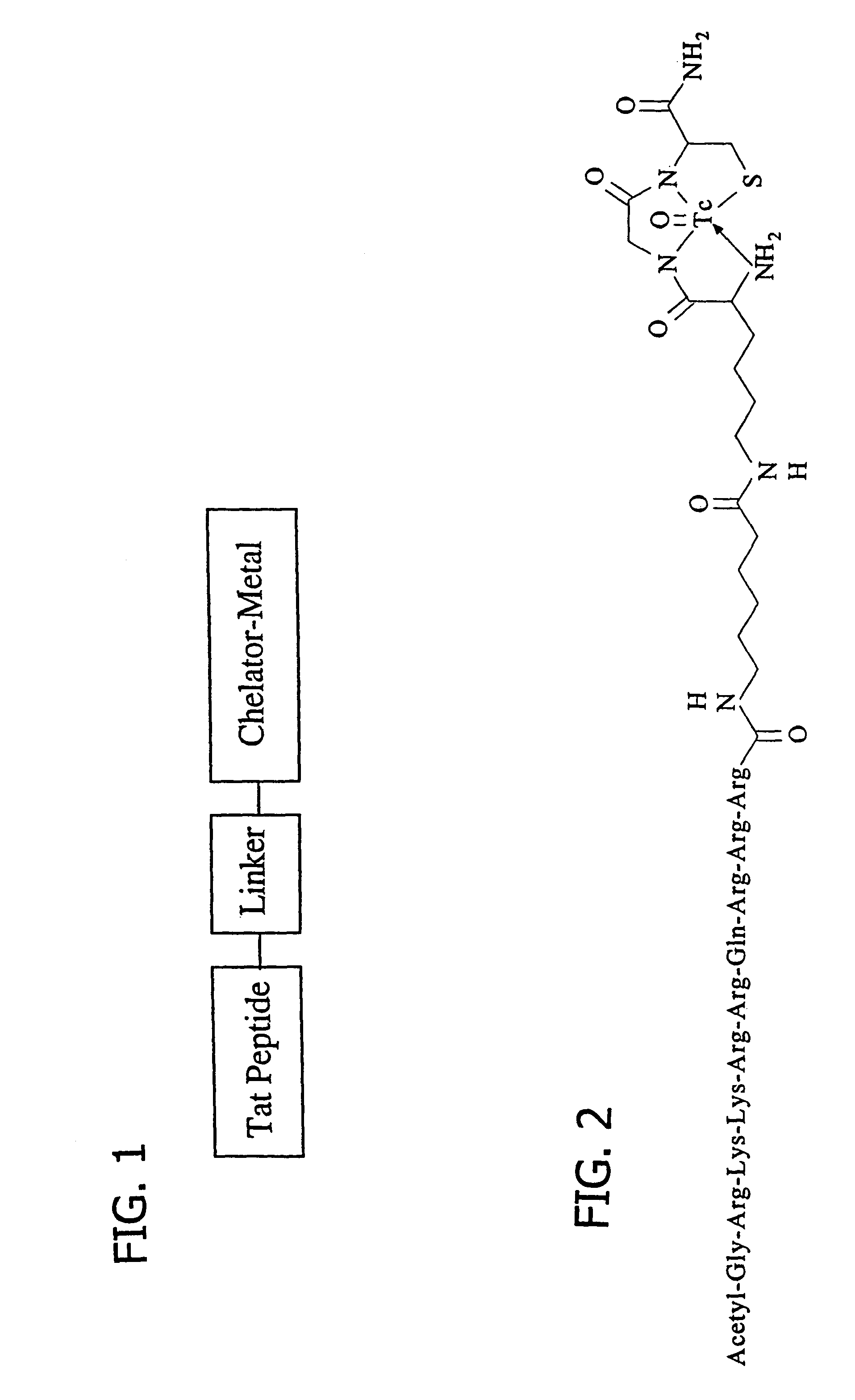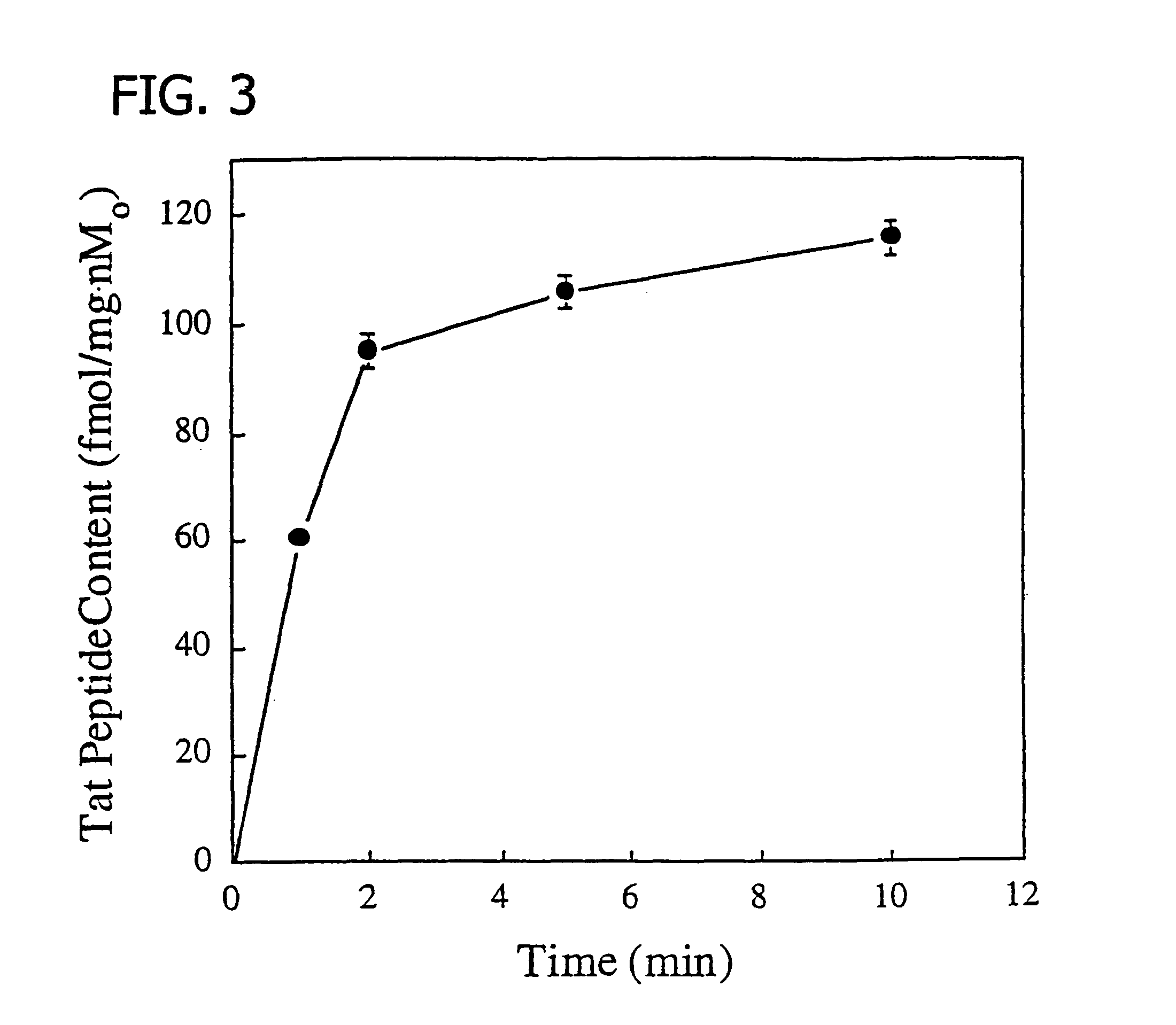Membrane-permeant peptide complexes for treatment of sepsis
a membrane-permeant peptide and sepsis technology, applied in the field of medicine, can solve the problems of sepsis being a major and growing health problem, sepsis remains a difficult condition to treat, and organ failure is approaching a quarter million patients per year, so as to protect against bacterial-induced cell depletion
- Summary
- Abstract
- Description
- Claims
- Application Information
AI Technical Summary
Benefits of technology
Problems solved by technology
Method used
Image
Examples
example 1
Preparation of acetyl-GRKKRRORRR-AHA-εKGC-amide trifluoroacetate
[0157]A Tat peptide (residues 48-57, GRKKRRQRRR (SEQ ID NO: 7)) conjugate was prepared by solid phase peptide synthesis using N-α-FMOC-protected amino acids and standard BOP / HOBt coupling chemistry (Merifield et al., Biochemistry 21:5020-5031, 1982; Houghten, Proc Natl Acad Sci USA 82:5131-5135, 1985; Lin, et al., Biochemistry 27:5640-5645, 1988), except for the ε-Lys residue, which used an N-α-tBOC, N-ε-FMOC-Lys residue to generate the desired peptide-based N3S chelating group for an incoming metal (Lister-James, et al., Q J Nucl Med 41:111-118, 1997). AHA represents aminohexanoic acid as an example of a non-functional linker between the Tat 48-57 residues and the chelating moiety. The peptide was amino acetylated, carboxy amidated, and deprotected by standard methods (Merifield et al., Biochemistry 21:5020-5031, 1982; Houghten, Proc Natl Acad Sci USA 82:5131-5135, 1985; Lin, et al., Biochemistry 27:5640-5645, 1988). T...
example 2
Preparation of radiolabeled acetyl-GRKKRRORRR-AHA-εKGC-amide(Tcv-99m) trifluoroacetate
[0158]The Tat peptide conjugate complex of Example 1 was labeled with Tc-99m by ligand exchange using Tc-99m-glucoheptonate as the ligand exchange reagent (Lister-James et al., J. Nucl. Med. 38:105-111, 1997). A commercially available stannous glucoheptonate radiopharmaceutical kit (Glucoscan, DuPont Pharma, Billerica, Mass.) was reconstituted with 1.0 ml of (Tc-99m)sodium pertechnetate (50 mCi) in isotonic saline obtained by eluting a commercial radionuclide Mo-99 / Tc-99m generator, and allowed to stand for 15 min at room temperature. In a small glass vial, Tat peptide conjugate (1 mg) was dissolved in 0.9% saline (1 ml). Then, (Tc-99m)glucoheptonate (250 μl) was added and the reaction allowed to proceed at room temperature for 15 min. Radiochemical yield (>95%) of the oxotechnetium complex (FIG. 2) and purity (≧90%) were determined by silica gel TLC using 15% TFA and radiometric detection (Bioscan...
example 3
Preparation of acetyl-GRKKRRORRR-AHA-εKGC-amide-fluorescein-maleimide trifluoroacetate
[0159]The Tat peptide conjugate of Example 1 was labeled with fluorescein according to Vives et at. (J. Biol. Chem., 272:16010-16017, 1997). In a small glass vial, Tat peptide conjugate (1 mg) was dissolved in phosphate buffered saline (pH 7.4) and reacted with 1.2 eq of fluorescein maleimide dissolved in dimethylformamide for 2 hours in the dark at room temperature. The reaction was monitored by RP-HPLC at both 211 nm and 440 nm. Fluorescent peptides were purified by HPLC (purity >97%) using the above gradient conditions and lyophilized in the dark. The identity of the desired fluorescein labeled peptide was confirmed by electrospray mass spectrometry (m / z: 2211.0).
PUM
| Property | Measurement | Unit |
|---|---|---|
| energy | aaaaa | aaaaa |
| pH | aaaaa | aaaaa |
| temperature | aaaaa | aaaaa |
Abstract
Description
Claims
Application Information
 Login to View More
Login to View More - R&D
- Intellectual Property
- Life Sciences
- Materials
- Tech Scout
- Unparalleled Data Quality
- Higher Quality Content
- 60% Fewer Hallucinations
Browse by: Latest US Patents, China's latest patents, Technical Efficacy Thesaurus, Application Domain, Technology Topic, Popular Technical Reports.
© 2025 PatSnap. All rights reserved.Legal|Privacy policy|Modern Slavery Act Transparency Statement|Sitemap|About US| Contact US: help@patsnap.com



